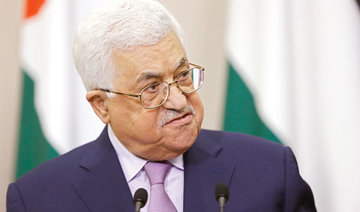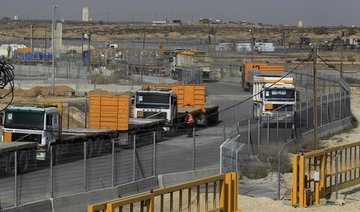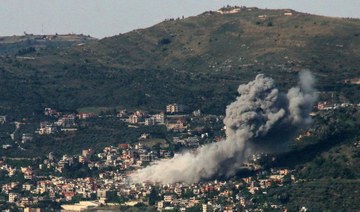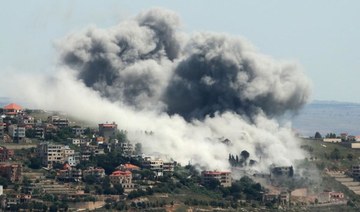JERUSALEM/RAMALLAH: Palestinian politics is a relentless and often fruitless pursuit: after more than two decades of on-off negotiations, a state remains out of reach. Now add to the mix rising age and failing health.
President Mahmoud Abbas, who will be 83 in March, has been in hospital for frequent check-ups in recent months and received treatment abroad. His chief peace negotiator, Saeb Erekat, is 20 years younger and a keen runner, but he is suffering from pulmonary fibrosis and needs a lung transplant.
Aides to Abbas say he remains strong and those who work with Erekat describe him as tireless, even when having to use an oxygen tank to aid breathing. In an e-mail, Erekat declined to discuss his health in detail, calling it a private matter. “I would like to keep it this way,” he said.
The fact that two of the most prominent Palestinians on the world stage are aging and, in Erekat’s case, in need of life-saving surgery has prompted questions in both Israel and the Palestinian territories about what comes next.
If the president of the past 12 years and his chief negotiator leave the scene, who would take over? And given the deep divisions in Palestinian politics, with Abbas’s Fatah party at sharp odds with Hamas, the militant movement that controls Gaza, what are the risks of internal armed conflict?
Most analysts and observers of Palestinian affairs see the chances of full-on fighting between Fatah and Hamas as remote, especially with Israel, which keeps Gaza under a tight blockade and occupies the West Bank and East Jerusalem, having an interest in preventing it.
And at the same time, while Abbas may have dominated the scene since Yasser Arafat’s death in 2004, it is not as if the Palestinians are without the political structures or wherewithal to find a viable successor, with several names in the mix.
“For now, there doesn’t seem to be any indicator that things are going toward violence” despite the “fertile ground” for it, said Khalil Shikaki, a leading pollster and analyst with the Palestinian Center for Policy and Survey Research.
“The most important factor is that the split, while creating frustration, also makes it difficult for Fatah and Hamas to trust each other and work together to launch violent attacks.”
Add to that the fact that Palestinian forces coordinate West Bank security with Israeli forces every day, despite civilian opposition, and the chances of a major outbreak of violence, either internal or aimed at Israel, appear limited.
The bigger concern may be how any transfer of power is handled, and whether it can be done smoothly.
“The situation is ripe for a power vacuum,” said Grant Rumley, a research fellow at the Foundation for Defense of Democracies in Washington and co-author of a biography of Abbas.
“If (the Palestinians) rally behind one figure, I think there is a chance of a peaceful transition. That looks less and less likely as it goes on.”
Abbas has kept a tight grip on power since he was elected to a four-year term in 2005. Presidential polls have not been held since. Opponents, like former Fatah security chief Mohammed Dahlan, have gone into exile. Hamas is regarded as as much of an enemy as Israel.
Despite Prime Minister Benjamin Netanyahu publicly dismissing Abbas as no partner for peace, Israel’s security establishment likes his steady hand and the fact he favors peaceful resistance over violence. Those best positioned around Abbas largely have the same perspective.
“The main candidates to inherit from Abbas all share his political program,” said Nathan Thrall, senior analyst with the International Crisis Group. “The likelihood that one of his successors... is going to support armed resistance or call for armed resistance is very, very low.”
Currently, two names are most often mentioned as successors: Majid Faraj, 55, the head of intelligence, who often joins Erekat in negotiations; and Mahmoud Aloul, 67, the chief deputy to Abbas in Fatah and a former governor of Nablus.
Aging and ailing, who will succeed current Palestinian leaders?
Aging and ailing, who will succeed current Palestinian leaders?
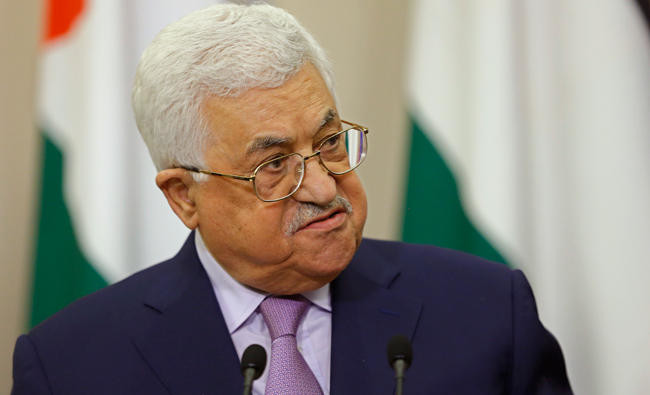
Hostages’ plight casts pall over Israel’s Independence Day

“Like in Pesach (Jewish Passover), I didn’t feel it’s really a holiday of liberation,” Lavi Miran added
TEL AVIV: On Israel’s 76th Independence Day, victory feels far away for many agonizing over the fate of dozens of hostages still held in the war-ravaged Gaza Strip.
“On one side we’re still here, my daughters are still here, my family’s still here, and Israel is still here,” said Lishay Lavi Miran, from the Nir Oz kibbutz community, less than a kilometer (0.62 miles) from the Gaza border.
“But it’s not really independence because... Omri is over there,” added the 39-year-old, referring to her husband who was kidnapped and taken to the Palestinian territory on October 7 alongside about 250 other hostages.
He is among 128 captives who remain in Gaza, 36 of whom the army says are dead.
On May 14 every year, Israelis celebrate the anniversary of their state’s creation.
But the more than seven-month war in Gaza and the absence of the remaining hostages have cast a long shadow over the normally joyous day.
“Like in Pesach (Jewish Passover), I didn’t feel it’s really a holiday of liberation. I don’t feel now that there is really something to be happy about,” Lavi Miran added.
Batia Holin, from the neighboring kibbutz community of Kfar Aza, expressed similar feelings, saying “there is no independence here.”
Several Kfar Aza residents are still captive in Gaza.
Holin and other residents of the southern Israeli communities surrounding the border with Gaza have been evacuated since the October 7 Hamas attack.
“Even though I am in my country, I cannot be in my home and I will not be able to return for at least three years,” Holin, 71, said. “What kind of independence is this?“
And in northern Israel, where there have been a regular exchange of fire between Israeli forces and Lebanon’s Hezbollah, tens of thousands have been displaced.
“They can’t go home and have become refugees,” lamented Holin.
The unprecedented October attack saw militants surge through Gaza’s militarised border and resulted in the deaths of more than 1,170 people, mostly civilians, according to an AFP tally of official Israeli figures.
Israel responded with a relentless military campaign in the Hamas-run territory that has so far killed more than 35,100 people, according to the Gaza health ministry.
Israel is “a sovereign country where its citizens are refugees... It’s terrible,” Holin continued, recalling a brief return home to the community where more than 60 people were killed. She shut the door and left.
“That’s it. I don’t have a home anymore.”
Israel was founded in 1948 on the vow of a “Jewish national home” with the promise of safety to Jews, six million of whom were murdered during the Holocaust.
Based on this promise, many migrated to the newly formed state, including Lavi Miran’s grandparents who arrived from Libya and Azerbaijan.
For Palestinians, that period is known as the “Nakba,” or catastrophe, marked on May 15 every year to commemorate the mass displacement of around 760,000 Palestinians during the war that accompanied Israel’s creation.
During the Hamas attack, fighters ransacked Lavi Miran’s home “and took a lot of things. Even after seven months, I can’t touch stuff over there,” she said.
“They trashed all the house. They threw all of our clothes.”
But to her, the priority remains the return of the hostages. She has joined the regular protests by thousands calling on the Israeli government to reach a deal that would bring them back.
On Sunday, during a ceremony marking Memorial Day to commemorate fallen soldiers and civilian victims of attacks on Israel, army chief Herzi Halevi acknowledged he was “fully responsible” for the events of October 7.
“Hamas won the war, because they’re not here,” said Lavi Miran, referring to the hostages.
“Home, it’s just when he comes back,” she continued, referring to her husband Omri, a 47-year-old massage therapist.
“It’s like a nightmare. They’re in hell.”
Israel army says civilian killed in rocket fire from Lebanon

- The army said in a statement that “several anti-tank missile launches were identified from Lebanon“
JERUSALEM: Israel’s army said rockets fired from Lebanon on Tuesday killed a civilian and wounded five soldiers on the Israeli side of the border.
“On the northern border, a civilian was killed today from an anti-tank missile that hit Adamit,” a kibbutz community on the border with Lebanon, army spokesman Daniel Hagari said in a televised briefing.
The army said in a statement that “several anti-tank missile launches were identified from Lebanon,” and that one soldier was moderately wounded and four others were lightly hurt.
UN says women and children at least 56 percent of Gaza war dead

- The United Nations was clarifying a fresh breakdown of the death toll in Gaza, after Israel slammed the world body for “parroting... Hamas’s propaganda messages“
- WHO spokesman Christian Lindmeier on Tuesday said the new breakdown as “the most comprehensive” provided to date
JERUSALEM: Women and children make up at least 56 percent of the thousands killed in the Gaza war, the UN said Tuesday, amid controversy over the toll based on numbers from the health ministry in Hamas-run Gaza.
The United Nations was clarifying a fresh breakdown of the death toll in Gaza, after Israel slammed the world body for “parroting... Hamas’s propaganda messages.”
“Anyone who relies on fake data from a terrorist organization in order to promote blood libels against Israel is antisemitic and supports terrorism,” Israeli Foreign Minister Israel Katz said on X, formerly Twitter, late Monday.
Due to a lack of access, UN agencies have since the beginning of the Gaza war on October 7 relied on death tolls provided by the health ministry in the Hamas-run territory.
This has drawn criticism from Israel, but the United Nations says the ministry’s tolls before the war were deemed reliable, and that it will strive to verify the figures “when conditions permit.”
The ministry said Tuesday that at least 35,173 people have been killed in the territory due to Israeli military operations since the war erupted.
The war was sparked by Hamas’s unprecedented October 7 attack on Israel, which resulted in the deaths of more than 1,170 people, mostly civilians, according to an AFP tally of Israeli official figures.
Gaza authorities have consistently said women and children make up a large majority of those killed in the Palestinian territory.
But a fresh breakdown provided by the health ministry and published by the UN last week appeared to cast doubt on that assertion.
The ministry said that as of April 30 it had fully identified nearly 25,000 of those killed, with identification elements missing for the remainder of the nearly 10,000 others who had died.
Of those fully identified, it said 40 percent were men, 20 percent women and 32 percent children, while another eight percent were elderly — a category not broken down by gender.
WHO spokesman Christian Lindmeier on Tuesday said the new breakdown as “the most comprehensive” provided to date.
He told reporters in Geneva that by applying the same ratio to the unidentified and assuming women represent half of the elderly, it could be expected that at least “56 percent women and children” were among the more than 35,000 dead.
And that did not take into consideration the likelihood that more women and children were likely to be among the thousands believed to still be under the rubble “because they are the ones typically staying at home,” he said.
So from a “minimum statistical calculation,” he said, “you come to 60 percent women and children.”
Jens Laerke, a spokesman for the UN humanitarian agency OCHA, said the new breakdown did not contradict previous estimates that women and children made up more than two thirds of those killed.
What had been provided by the health ministry now was simply “more detail about a sub-section of the overall tally of 35,000 deaths,” he said.
“These are not mutually exclusive.”
Why armed groups still dominate Libya, 13 years since the fall of Qaddafi

- Libya is divided between the UN-recognized government in Tripoli and the Haftar administration in the east
- Hundreds of thousands of Libyans remain internally displaced or in need of humanitarian assistance
DUBAI: Muammar Qaddafi’s capture and killing by rebel fighters near his hometown of Sirte on Oct. 20, 2011, failed to usher in the era of stability and democracy that Libyans had hoped for when mass protests erupted earlier that year.
Instead, despite the best efforts of the UN Support Mission in Libya, the country remains deeply insecure, divided by two rival administrations, and fragmented among a plethora of armed groups vying for control.
“The fracturing of the Libyan body politic, with the emergence of dual governments and empowered militias, has posed perhaps the most significant challenge,” Hafed Al-Ghwell, a senior fellow and executive director of the North Africa Initiative at the Foreign Policy Institute of the Johns Hopkins University School of Advanced International Studies, said in a recent op-ed for Arab News.

“An enduring stalemate remains underpinned by a lack of consensus on constitutional and electoral frameworks, deepened by the entrenchment of local and international stakeholders in the status quo.”
Libya is split between the UN-recognized Government of National Accord of Prime Minister Abdul Hamid Dbeibah based in Tripoli, which controls barely a third of the country, and the Government of National Stability of Gen. Khalifa Haftar based in Benghazi.
The latest effort to bridge this divide culminated in the creation of a joint committee by the House of Representatives and the Government of National Unity-aligned High State Council, which aimed to pave the way for national elections. These, however, are still yet to take place.
A meeting in Cairo under Arab League auspices in March and efforts by the African Union to organize a national reconciliation conference in early February also did little to help UNSMIL bring about elections and national reconciliation.
“Rapidly evolving from a need to stabilize post-revolution Libya into addressing deep-seated political divisions and external interference, (the UN’s) mandate has consistently proven ill-suited to the complexities of the Libyan context,” said Al-Ghwell.
“It has devolved into merely managing failure, rather than being a well-orchestrated attempt at resurrecting democratic governance in a post-Gaddafi Libya.
“Its emphasis on mediation and political dialogue, while noble, has failed to account for the leverage that will be necessary to fully enforce ceasefires, manage the transition to governance or curb the influx of arms and mercenaries bolstered by self-interested external meddlers.”
On April 16, Senegalese diplomat Abdoulaye Bathily tendered his resignation as the UN’s special envoy for Libya, saying he was unable to support the country’s political transition while its leaders continued to put their own interests above finding a solution.

“Under the circumstances, there is no way the UN can operate successfully. There is no room for a solution in the future,” Bathily said in a statement at the time, announcing the delay of a national reconciliation conference originally scheduled for April 28.
“The selfish resolve of current leaders to maintain the status quo through delaying tactics and maneuvers at the expense of the Libyan people must stop.”
As the country’s finances are split between the two governing powers, which are backed by competing foreign players, the matter of their legitimacy in the eyes of Libyans and the international community remains an issue.
Foreign involvement is arguably the main reason why Libya has been unable to move on and establish a unified, stable administration. By sponsoring their preferred side in the conflict, experts say external actors have periodically added fuel to the fire.
Indeed, experts believe Libya has become little more than a playground for competing foreign interests, with the spoils of war — oil, arms contracts, and strategic influence — up for grabs.

To further these aims, various outside interests have sponsored militias inside Libya, thereby compounding and prolonging the fragmentation of the nation’s security apparatus.
Haftar commands the Libyan Arab Armed Forces, also known as the Libyan National Army. Although multiple armed groups serve under its banner, many operate under their own command structures and engage in their own raids and patrols across eastern Libya.
Meanwhile, in western Libya, prominent militias such as the Stability Support Apparatus, Misrata Counter Terrorism Force, Special Deterrence Forces (known as Radaa), 444 Brigade, 111 Brigade, Nawasi Brigade, and Joint Operations Force engage in their own state-sanctioned activities.
These include intelligence gathering and surveillance, street patrols, border security, and overseeing migrant camps.

“In today’s Libya, armed groups are the only entities capable of projecting power and maintaining territorial control,” Jalel Harchaoui, an associate fellow at the UK-based Royal United Services Institute, told Arab News.
“These groups lack a limpid chain of command and do not always follow the authority of the central state or manage their personnel in a clear and organized manner. They are inherently informal, often flawed, and dysfunctional.
“Despite their shortcomings, they are powerful when it comes to controlling territories and using force.”
Although these armed groups have been tasked with improving the nation’s overall security situation, they frequently clash with one another. This violence has shown little sign of abating, despite international efforts to establish a unified government and security apparatus.
Fifty-five people were killed in August 2023 when Radaa and the 444 Brigade engaged in running street battles in Tripoli. In February this year, at least 10 people, including members of the SSA, were shot dead in the city.
During this year’s Eid Al-Fitr celebrations, clashes broke out in the capital between the SSA and Radaa militias. Although this most recent bout of violence incurred no casualties, it raised fresh concerns about the country’s perilous security situation.
While the humanitarian situation in Libya has somewhat improved since the UN-facilitated ceasefire agreement of October 2020, civilians continue to bear the brunt of political and economic instability.

Militia skirmishes have resulted in the internal displacement of some 135,000 people. Another 300,000 are in need of humanitarian assistance, according to UN reports from 2022.
The dire humanitarian situation was made worse by the devastating storm that pounded the Libyan coast in September last year. Storm Daniel burst two dams in the eastern city of Derna, with the resulting torrent of water flattening everything in its path.
The storm killed at least 5,900 people and displaced more than 44,000, according to the US Agency for International Development.
“Achieving stability in Libya requires a long-term strategy that would take many years and involve significant commitment from key foreign states,” said Harchoui.
“This would demand dedication and the willingness of countries like the US to challenge their regional partners, such as Turkiye, the UAE, and Egypt. It’s a major undertaking by all means.”
The SSA and Radaa are not under the direct authority of Libya’s interior or defense ministries. Nevertheless, they receive public funds and operate independently under a special status granted in 2021 by the prime minister and the presidential council.
Armed groups in Libya are often accused by the UN and human rights groups of committing war crimes with impunity. A report published by the UN last year found that these militias had engaged in murder, rape, arbitrary arrest, and slavery.
A 2023 report by Amnesty International also found that groups like the SSA, LAAF, and several others had committed acts of sexual violence, abductions, mock executions, and had restricted freedom of expression.
Libyan civilians have no power to hold these groups to account — particularly those backed and legitimized by the state.

An initial step toward achieving stability, Harchaoui believes, is recognizing that armed groups have infiltrated government institutions to become integral parts of the Libyan state and are “increasingly involved in corrupt and illegal activities.”
He said: “Tackling corruption should therefore be the initial focus, as this would slow the expansion of armed groups into areas beyond physical security, like government administration, finance, oil, and wealth extraction writ large.
“Once corruption is addressed, further steps can be considered.”
There are, however, multiple factors behind the Libyan military’s inability to rein in the country’s many armed groups.
Chief among these is that Libya’s “political leaders, economic institutions, and foreign states still need the protection of these armed groups for day-to-day operations,” said Harchaoui.
“This protection is needed for activities like oil production, diplomacy, contract signing, and counterterrorism intelligence gathering.”
These operations, he says, allow these groups to become more entrenched and powerful — and, in turn, make it more difficult to reduce their influence.
“This paradox means that continuing to rely on these groups for daily operations only strengthens them, preventing the ultimate goal of replacing them with formal forces some day in the future.”

There were some green shoots of change in July 2023 when the two rival administrations agreed to set up a committee to oversee the sharing of Libya’s significant oil revenues.
In a statement at the time, UNSMIL said it “welcomes the decision announced by the Presidential Council to establish a High Financial Oversight Committee to address fundamental issues of transparency in the spending of public funds and fair distribution of resources.”
Nevertheless, far from emerging from the Qaddafi era with greater openness, economic growth, and productive engagement with the international community, Libya continues to endure lawlessness and institutional collapse, becoming something close to a failed state.

2 Houthi drones, 1 missile destroyed over Red Sea, says US

- The intercepted drones and missile caused no harm to the US-led marine coalition or international commercial ships in the Red Sea
AL-MUKALLA: Yemen’s Houthis launched two drones and one ballistic missile over the Red Sea on Monday, but all failed to reach their targets after being destroyed by the US Navy, in the latest round of Houthi attacks on ships in international commercial lanes.
US Central Command said the Houthis fired a drone from their controlled areas in Yemen at 3:41 p.m. on Monday, which was shot down by US Navy forces before reaching its intended objective.
Nearly three hours later, US military forces shot down one inbound anti-ship ballistic missile and a drone fired by the Houthis over the Red Sea, according to CENTCOM.
The intercepted drones and missile caused no harm to the US-led marine coalition or international commercial ships in the Red Sea.
This comes as the Houthis said on Monday that US and UK warplanes conducted an airstrike on Hodeidah airport in the western province of Hodeidah, the latest round of military actions by the two nations against Houthi targets in Yemeni territory under their control.
The Houthis have seized a commercial ship, sunk another and claimed to have fired hundreds of ballistic missiles and drones at more than 100 ships in the Red Sea, Bab Al-Mandab Strait, Gulf of Aden and recently in the Indian Ocean since the beginning of their campaign in November.
The Houthis claim that they only target ships linked to or sailing to Israel in order to pressure the latter to end its war in Gaza, and later attacked US and British vessels after those countries launched strikes against Yemen.
On Monday, a Yemeni government official told Arab News that a team of UN experts who visited the Belize-flagged and Lebanese-operated MV Rubymar that sank in the Red Sea after being hit by Houthi missiles in February suggested that it is impossible to retrieve the ship and bring it to shore or remove its cargo of 22,000 tonnes of ammonium phosphate-sulfate NPS fertilizer, disappointing Yemeni and international environmentalists who have long warned of an ecological disaster in the Red Sea.
The Houthis on Sunday allowed a team from the International Committee of the Red Cross and a group of journalists to visit the seized Galaxy Leader ship and its 25 crew members off the coast of Hodeidah.
The ship was taken by the Houthis in November, during the early stages of their ship attacks.
“The ICRC has visited crew members who were detained following the seizure of the Galaxy Leader vessel in Yemen. During this humanitarian visit, ICRC passed on family messages to the crew members,” the ICRC delegation in Yemen told Arab News.
Meanwhile, Amnesty International has urged the Houthis to free a Yemeni teacher who has been held in a notorious Houthi prison center for over six months.
The international rights group said in a petition addressed to the militia’s chief negotiator, Mohammed Abdul Sallam, that the Houthis abducted Moujib Al-Mikhlafi, a middle-aged educationist and human rights trainer, in October last year while he was traveling to the province of Ibb to give a teacher training course.
The Houthis stormed his home and stole his electronics and paperwork, abducted him on the same day, held him for 21 days, and then threw him into a security and intelligence jail in Sanaa, where he was tortured and refused treatment, according to the group.
“We urge the Houthi de facto authorities to immediately release Moujib Al-Mikhlafi. Pending his release, the authorities must ensure he is protected from torture and other ill-treatment and that he has access to legal representation, regular family contact, and adequate healthcare,” Amnesty said, adding that his family said that his health has worsened in recent months and that he requires medical care for diabetes and high blood pressure.
The Houthis have not put Al-Mikhlafi on trial or explained why they are keeping him.



